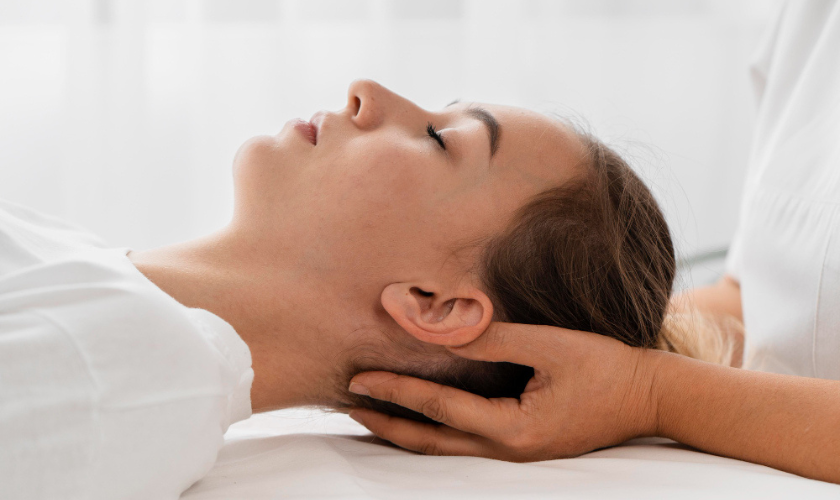Are you tired of experiencing jaw pain, headaches, and difficulty chewing? If so, you may be suffering from a disease known as TMJ disorder. But don’t worry – relief is possible through various forms of therapy! In this ultimate guide, we’ll explore the different types of TMJ therapy available to help alleviate your symptoms and improve your overall quality of life. So say goodbye to difficulty and hello to a happier, healthier you with our comprehensive tips and tricks for finding relief with TMJ therapy.
Introduction to TMJ Disorder
It is a condition that affects the temporomandibular joint, which is the joint that joins the lower jaw to the skull. The disorder can cause pain and stiffness in the jaw, Face pain, Headaches, Ear pain, and Difficulty chewing or opening the mouth. TMJ disorder can be caused by some things, including teeth grinding, clenching, stress, arthritis, and injury. There is no one-size-fits-all solution for TMJ disorder, but several treatments can help relieve the symptoms.
Symptoms of TMJ Disorder
There are many symptoms associated with TMJ disorders. The most well-known symptom is pain in the jaw, which can be felt in the temples, cheekbones, or around the ear. There may also be clicking or popping sounds when moving the jaw, and pain may worsen when chewing or yawning. Headaches, neck pain, and dizziness are also common symptoms.
Diagnosing TMJ Disorder
If you are undergoing any of the following symptoms, you may have TMJ disorder:
– Pain in the jaw, face, neck, or shoulders
– popping or clicking sound when opening or closing the mouth
– difficulty chewing or pain while chewing
– pain when yawning
– joint stiffness
– headaches
– earache
Treatment Options for TMJ Disorder
There are many different treatment options available for those suffering from TMJ Disorder. While some people may find relief with over-the-counter pain medication or home remedies, others may need more aggressive treatment options. However, here are some common treatment options for TMJ Disorder:
• Over-the-counter pain medication: This is often the first line of defense against TMJ pain. Ibuprofen and acetaminophen can help to reduce inflammation and pain. However, if you are taking blood thinners or have other medical conditions, check with your doctor before taking any over-the-counter medications.
• Home remedies: Some home remedies can help to ease TMJ pain. These include applying ice or heat to the affected area, eating softer foods, avoiding hard or chewy foods, practicing good posture, and avoiding clenching or grinding your teeth.
• Physical therapy: A physical therapist can help to stretch and strengthen the muscles surrounding the jaw joint. It can help to reduce pain and improve function.
• Surgery: In some instances, surgery may be necessary to correct the underlying cause of TMJ Disorder. It is typically only recommended as a last resort after all other treatment choices have failed.
Benefits of TMJ Therapy
There are many benefits of TMJ therapy. For one, it can help to relieve pain and discomfort in the jaw area. It can also help to improve the range of motion in the jaw and to reduce clicking and popping sounds in the jaw. Additionally, TMJ therapy can help to improve the overall function of the jaw and to prevent future problems with the jaw.
Tips for Managing TMJ Symptoms at Home
You can do several things at home to help manage your TMJ symptoms. Here are a few tips:
1. Apply ice or heat to the affected area. It can help to reduce pain and inflammation.
2. Avoid overuse of the jaw muscles by eating soft foods and avoiding gum chewing.
3. Practice good posture and alignment to remove the stress on the jaw muscles and joints.
4. Perform gentle stretching and massage exercises for the jaw muscles.
5. Use relaxation techniques to help reduce muscle tension and pain.
TMJ therapy is a type of physical therapy that helps to relieve pain and other symptoms associated with temporomandibular joint (TMJ) disorders. TMJ disorders can cause many symptoms, including pain, clicking or popping sounds when you move your jaw, difficulty chewing or swallowing, and lockjaw. While there is no cure for TMJ disorders, physical therapy can help to improve your symptoms and quality of life.
FAQs About TMJ Therapy
1. What is TMJ therapy?
TMJ therapy is a form of physical therapy used to treat temporomandibular joint (TMJ) disorders. TMJ disorders are a type of disorder that can give rise to pain and other symptoms in the jaw area. With TMJ therapy, a physical therapist will work with you to help improve your symptoms.
2. What are the benefits of TMJ therapy?
The benefits of TMJ therapy include the following:
- Reducing pain.
- Improving the range of motion in the jaw.
- Helping you to avoid surgery.
In some cases, TMJ therapy may also help to improve your ability to chew and swallow food.
3. How long does it take to see full results from TMJ therapy?
The time it takes to see results from TMJ therapy varies from person to person. In general, however, you can expect to see some enhancement in your symptoms within a few weeks of beginning treatment. It may
Conclusion
Finding the right TMJ therapy can be difficult, but it is worth it in the end. With the right treatment combination and dedication to your recovery, you can find relief from your jaw pain and achieve a better quality of life. Remember to consult with your dentist or doctor before starting any new therapy or changing any existing treatments. These steps will help ensure you get the best care possible for your needs and goals.


